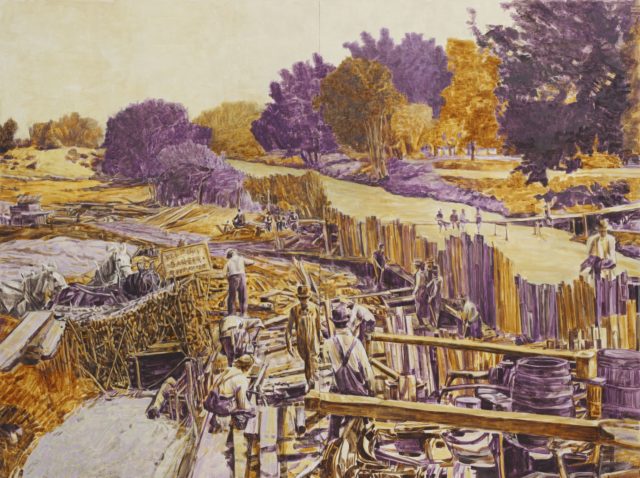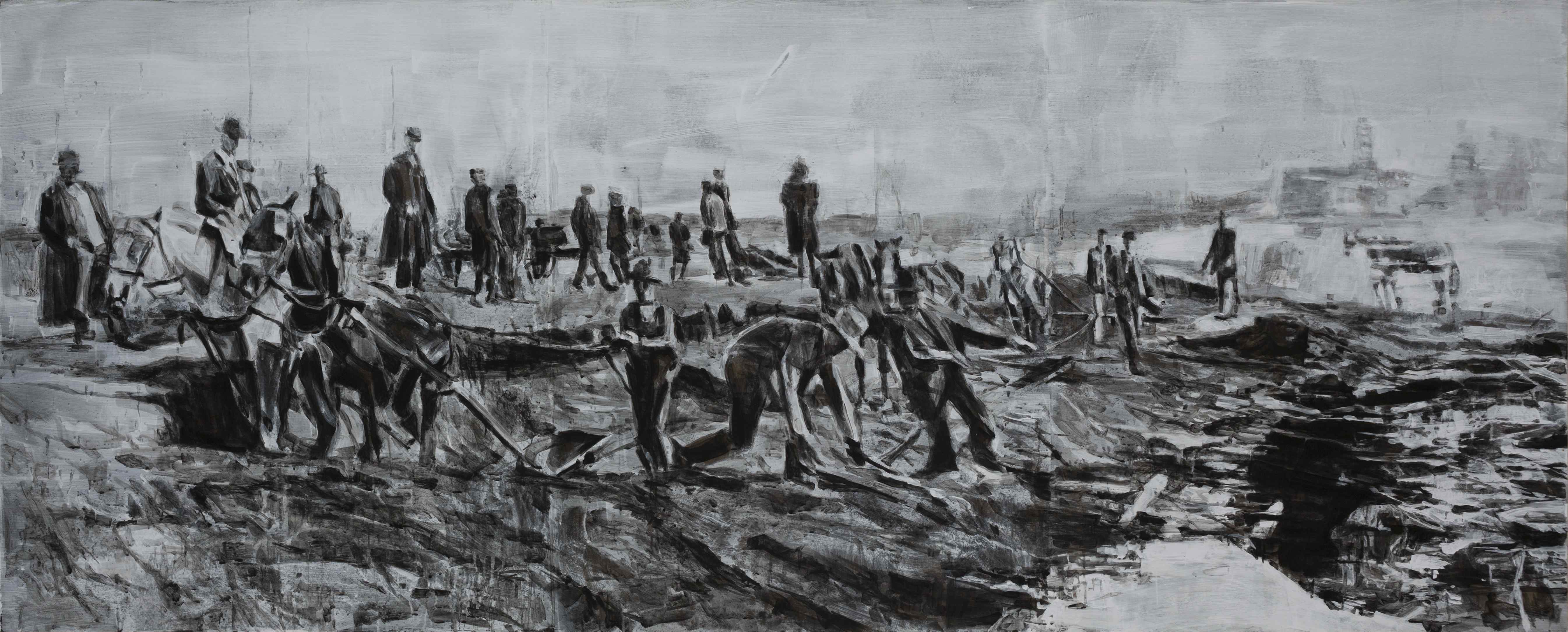
It’s hard to timestamp one of Stephen Batura’s paintings. While the scenes feel familiar — a river, a field or a construction site — there’s an otherworldly quality about them.
“My intention is to confuse that issue,” Batura says. “When I’m gone, [my paintings] will be very strange objects. People will double-check dates, and they’ll find it tricky to date. That’s what I want, to blur those lines and make the audience deal with the fact that it’s not identified clearly, and what that means.”
On view at the Boulder Museum of Contemporary Art through Jan. 21, River Paintings features more than a decade of Batura’s work.
It all started about 15 years ago. At the time, Batura was painting another series depicting train wrecks. During his research of historical photos, he continually came across the work of early-20th-century photographer Charles Lillybridge.
Lillybridge worked in Denver from about 1905-1935 using a tripod camera with glass plates. At some point, Lillybridge’s plates were donated to the Colorado Historical Society, which then digitized them. Batura became fascinated by the work, drawn to this large conglomeration of photos that covered a wide range of subject matter.
“There were candids of people. [Lillybridge] took pictures of people in the parks having picnics. He took lots of pictures of houses around his neighborhood, on the outskirts of Denver. He just wandered around taking pictures; they’re very casual,” Batura says. “He’d take a picture of a bush. He took a picture of an empty street with nothing. There’s almost hardly anything in the picture, just the street.”
The photos lack a professional quality that makes Batura think Lillybridge was an amatur. That and the fact that many of the photos contain fingerprints and scratches. Also, considering the content matter, the photos don’t seem highly controlled, which was odd for that time period.
“It’s kind of a rare thing to find old photographers who aren’t trying to make things like a painting or that aren’t very formal. I really like that quality,” Batura says.

In all, the collection contained roughly 1,900 pictures from Lillybridge. In 2001, Batura decided he was going to render something new out of every one of Lillybridge’s images.
From the photos, Batura has created drawings, prints and paintings. Yet he still knows little about the man behind his inspiration.
“The Historical Society told me that there was just no information on [Lillybridge],” Batura says. “The little bit that there was suggested he was this outsider that didn’t have much contact with people. That was a fascinating part for me too, that he was just this obsessed guy doing it for his own reasons.
“He had a family, and he had a little shack by the river,” Batura continues. “I can’t really tell how he lived. I don’t think he made his living from his images. I think he was more than a hobbyist. He was definitely obsessive about recording all these things going on in the outskirts of Denver.”
But despite spending so many years working with Lillybridge’s photos, Batura was never particularly interested in the personal details of the photographer or his work.
“I tried to make the [work] not be sentimentalized and not pin historical attachment to it. My plan was to not reference history,” he says.
None of the people or the places in photos were identified by Lillybridge, and the vague nature of the photos aids the timeless quality of the work. The tree or house Lillybridge photographed could still be found on the outskirts of Denver today.
While Batura has identified some of the landmarks in Lillybridge’s photos, he never sought to track down specifics.
“The mystery of it was what interested me,” Batura says.
Detachment has always been a component in Batura’s work, as in his series on train wrecks, for example.
“I wasn’t interested in doing a train wreck that happened last year in New York,” he says. “I liked the fact that I’m looking at something that happened in 1935, and that I don’t have any emotion about it that I might if I knew more about it.”
He followed that impulse with his decision to translate Lillybridge’s work into his own.
“I think that’s what drew me into using someone else’s life to provide me with imagery — here I am looking at life through someone else’s eye,” Batura says.
And even though he draws inspiration from the photos, Batura adds his own artistic quality to the paintings. Because of the nebulous content the photos provided, Batura had freedom to interpret them through his own lens. He used multiple tactics to make the images current and contemporary, most notably by experimenting with color.
In “Homeland,” Batura paints a scene in a field of workers building a fence. The color palette alternates between a deep purple and rich yellow — yellow skies and grounds, purple trees and wood planks, the people a mix of the two colors.
“I’m trying to suspend the realism and the naturalism of the scene,” he says. “That lets me do things with paint that start to verge on abstraction.”
The coloring technique also adds to the dreamy quality of Batura’s paintings; devoid of any concrete context, the pictures whimsically float somewhere in time.
“I have been interested in this idea of time revolving,” he says. “You see a face, and it looks like someone you know now, but it’s a photo taken 100 years ago.”
By working so closely with Lillybridge’s collection, Batura began to notice the circular nature of time. Some of the houses Lillybridge photographed still exist in Batura’s neighborhood.
“I could walk across the street and make a painting of a house that was built the same year he took the picture,” he says. “This recurring theme became something that really fascinated me.

“They’re historical,” he continues. “But it’s more about the recurrence of people and their desires and their motivations that keep coming up and [still] seem very relevant to me now.”
Batura finished his Lillybridge project last year. In all that time, he’s learned a very simple lesson.
“I learned 15 years is a long time,” he says with a laugh.
But moreso, Batura gained an appreciation for time and what a lifetime of work really looks like.
“The weight of all this material that he spent probably 30 years photographing — that was always in my mind,” he says. “I was kind of living in this guy’s life, however long it took me to get through it.
“This is what this guy left behind,” he continues. “And I ’m recreating it for other people to discover in their own way.”
On the Bill: Stephen Batura: River Paintings. Boulder Museum of Contemporary Art, 1750 13th St., Boulder. Through Jan. 21.














